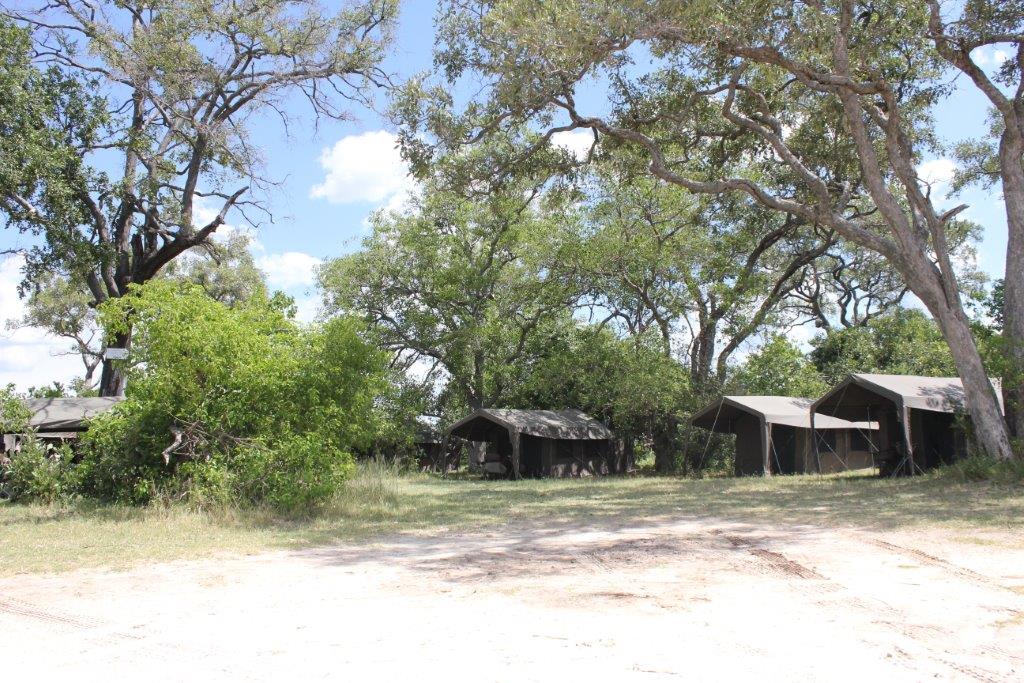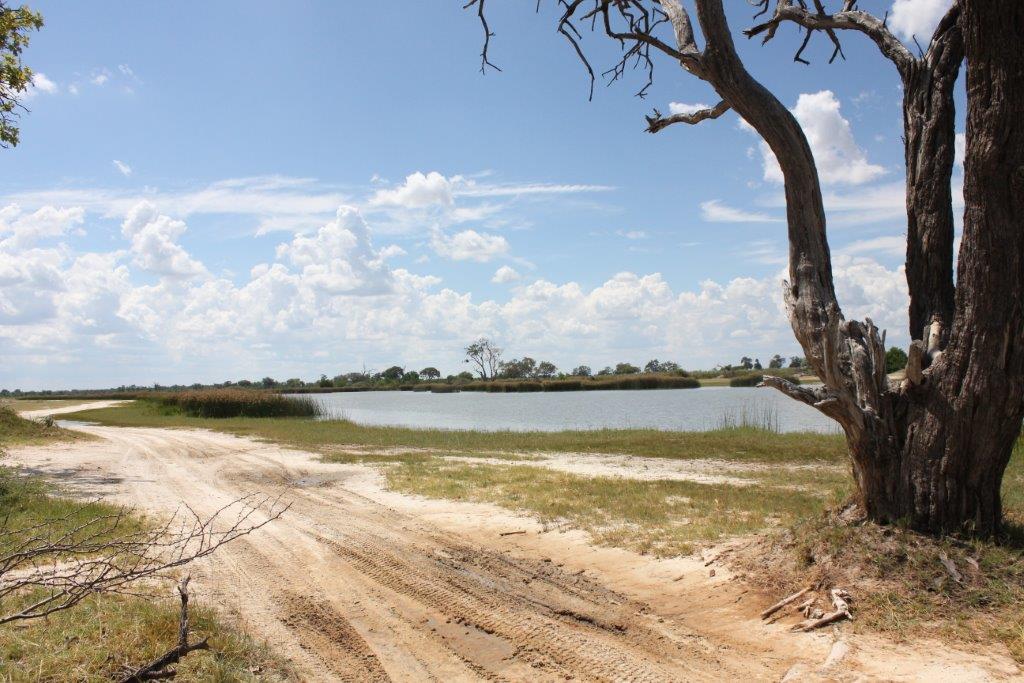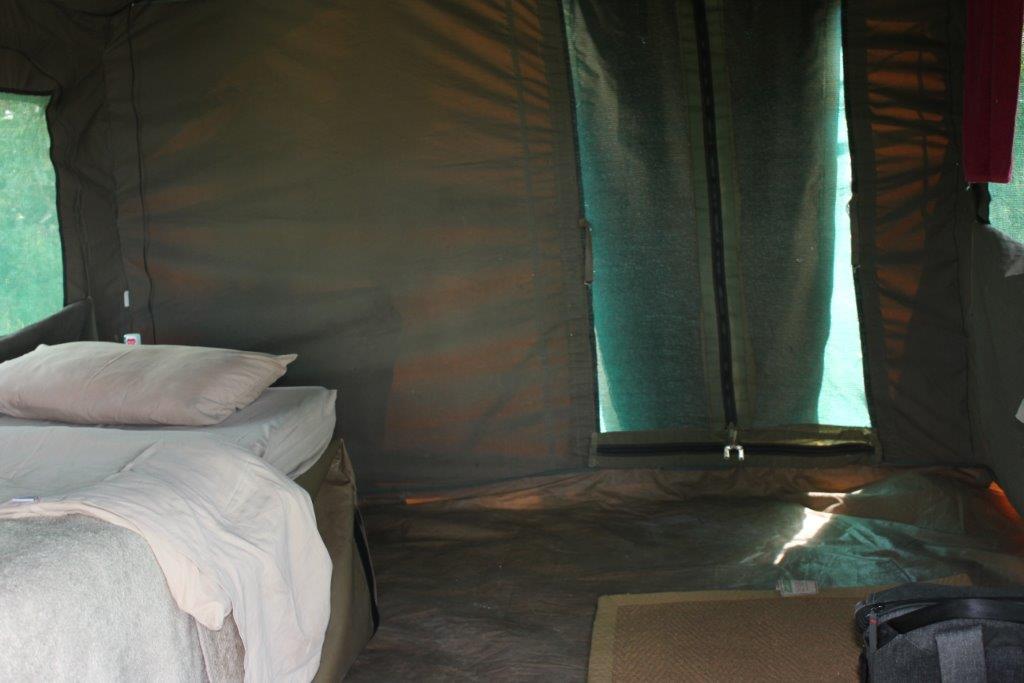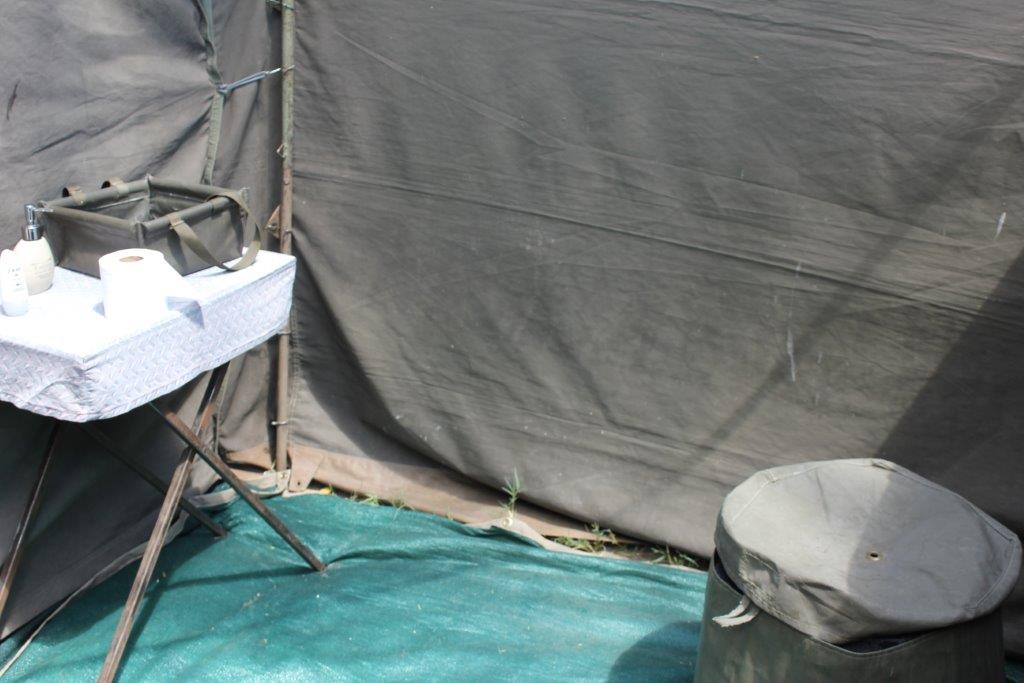 Mobile Safaris – Camping or Glamping?
Mobile Safaris – Camping or Glamping?
Wildfoot Travel Advisor Debbie Grainger took a trip to Botswana recently, sleeping under the stars on a mobile safari.
Here, Debbie gives us a first hand account of this remarkable wildlife adventure.
If experiencing Botswana in the unspoilt wilderness is what you’re after from your next safari trip, then a mobile safari is a must for you!
My mobile safari was a six-night trip. This involved me camping for three nights next to a waterhole full of hippos just outside the Moremi Game Reserve, followed by another three nights beside a river in an exclusive campsite in the Khwai Community area.
I’m going to be honest right from the start. When asked if I wanted to go camping in Botswana, my immediate reaction was ‘no thank-you!’. I like my creature comforts, and I enjoy a touch of luxury. The thought of sleeping in a tiny canvas tent and having to find my way to a camp toilet in the middle of the night didn’t appeal to me. I kept thinking about how was I going to have a proper shower and wash my hair? Especially in the warm African climate.
I’m not the only person to think of camping in this way. People often say to me that they don’t want to have to put up their tent or cook their food every day while on holiday. Well, with WILDFOOT Travel’s mobile camping trips, the only things you need to do is immerse yourself in the complete wilderness that surrounds you; Let your safari guide educate you about animal welfare, habitats and poaching, along with many other educational bits of information that you might not know about; And don’t forget to let us know which your favourite sundowner tipple is.
The Campsite and Tents
Let me tell you about your Botswana safari campsite and the tents first of all.
The maximum number of guests on each trip is seven. So, everyone can sit next to the open side of the jeep while enjoying an excellent viewing vantage. There were six of us on my trip – 2x twin tents and 2x single tents.
The tents were nicely spaced out, giving everyone privacy from their neighbours, but creating a feeling of safety in numbers from any midnight prowlers. The actual settings were spectacular; we couldn’t have chosen a more idyllic place to camp with the wildlife right on our doorstep. It was breath-taking to see the animals in their natural environment.
Just across from our tents was the dining area. This consisted of one long table, so we all ate together, and another long table where the food was laid out. The crew had their own dome tents. There was also a kitchen tent that they set up away from our tents.
The Sahara-style tents were the same size and measuring 4m x 3m with a high roof. Each tent came with an attached 2m x 3m en-suite bathroom and a 2x 3m covered area in front. The tents were equipped with a proper solid bed with mattress, bedsheets, a thin duvet and a blanket for the cooler nights. There are a small bedside table and a small hook-up canvas clothes storage.
I planned my outfits for the 3-day trip in each camp and folded them into this storage area, so that I could shut my case back up. There is just the one LED light fitting in the main tent, which casts a shallow light, so I recommend bringing a good headtorch with you. You wake up in the dark, and you go to bed in the night, so additional lighting is sometimes required. However, the camp crew do place oil lamps outside each tent in the evenings, and around the campsite, which helps you to navigate your way around the campsite.
Each tent is well sealed, and each of the windows has zips to let in air and light, while the door to the en-suite is double zipped. This reduces the chance of bugs getting in and out of your tent – so remember to zip up behind you each time you enter or leave the tent.
The toilet is a long-drop loo with a fixed wooden seat and a canvas lid. You’re supplied with a bucket of soil to throw down the toilet after you’ve finished. There’s a bucket-shower in the en-suite, and you can ask for the temperature of the water to be as hot or as cold as you like. Your camp crew will want to know what time of the day you prefer to take your shower to prepare the water for you – they do this over the kitchen campfire. I tended to take my shower in the afternoon around 2pm. This meant that I showered in between game drives, and in the daylight. There is no light in the en-suite – it’s open-air, so a light would attract all sorts of bugs, but this is where a headtorch also comes in handy. Both hand and bath towels are provided, along with hand wash. For any families with young children, they can have a two bedroomed tent with an adjoining en-suite and a lockable exit/entrance with each tent taking two people.
A Typical Day on a Botswana Safari Tour
So, now that you know more about the camping side of this safari trip let me tell you what your day will be like.
You’re woken up around 5.15am. Warm water is brought to your outside canvas washbasin so you can freshen up before breakfast. Breakfast is served at 5.45am. It’s a simple breakfast of a choice of cereals, freshly baked bread, juice, tea and coffee.
You’ll start your first game drive straight after breakfast – this is generally the best game viewing time. After about 3 hours of your exhilarating game drive, there’ll be a comfort stop, plus tea, coffee and cookies to keep you going until lunchtime. You’ll arrive back at camp around 11.30. Your camp crew will welcome you back into camp with a lovely cold face towel (or a warm one on colder days) and a welcome home soft drink.
After a light lunch, the next few hours are for you to spend as you want – maybe catch up on some sleep, write up your travel notes or look through your fantastic safari photos.
Afternoon tea was the highlight of my afternoon in camp. A delicious home-made cake was served at 3pm with tea or coffee. And then at 3.30pm, we were onto our next adventure on a late afternoon game drive.
Some days we had our sundowners while out on the drive, whereas other evenings we had them when we got back to camp, around the campfire. Our evening meals were delicious, and I often thought about how it was possible to create such delicious food over a campfire! Due to the early starts, most people tended to retire to bed around 9pm.
If you’re on one of the two or three centre trips, you will be asked to have your bags packed before breakfast on moving day, so that the safari crew can get them onto the trailer before you leave camp. You’ll see the guys dismantling your mobile safari camping tents while you’re having breakfast. The trailer with your luggage comes along on the back of the jeep. It amazed me how our driver/ safari guide managed to negotiate his way over the rough grounds and squeeze quietly alongside a pack of lions with their kill!
As this is moving day, we were taken to a river in the Khwai community area for our lunch. As we ate our freshly made sandwiches, we watched in awe at the hippos wallowing in the river. Now and again, there would be a loud roar as another hippo wanting his place nudged a disgruntled hippo. I don’t know if you can make out from the below photo – all the eyes and nostrils pointing in our direction.
By the time that we arrived at our new campsite, all of the tents were set-up. Our camp crew were all waiting for us with cold facecloths, a cold welcome drink and big smiles on their faces! As this is usually a long day, there isn’t another game drive that day, so we went into our tents to unpack and get ready for the sundowners before dinner.
There were two highlights of moving day for me. The first one was experiencing an immense pride of lions with their kill of a giraffe. The second highlight was seeing a pack of around 20 wild dogs making their way between Moremi and Khwai.
At the start of this blog, I mentioned that I wasn’t keen on participating in a mobile safari, but as each day passed, I learned to love it! I never felt that my life was in danger while sleeping in my tent. I relished in the absolute wilderness of the campsites and looked forward every morning to the thrill of my next game drive.
I came back from my experience thinking about how wasteful we are with water and electricity. And I was so pleased to see that there is no trace of settlement once the group leaves, making it an environmentally sound choice.
Your Botswana Safari Trip Includes:
- Spacious and comfortable tented accommodation, including beds and bed linen, with a private bathroom en-suite.
- Services of a professional guide, safari chef and camp assistants, complete with a supply vehicle.
- Game drives and local transfers in customised safari vehicles.
- Exclusive camping in private campsites within the national parks and reserves.
- All entrance and camping fees within the national parks and reserves.
- All meals and drinks (mineral water, soft drinks, beer, wine and G&T).
- All activities as specified in your specific itinerary.
- 12% Value Added Tax.
A Few Tips For Camping On A Botswana Safari
Take a battery power pack with you so you can connect multiple USB cables. This way, you only have to charge one device on the safari jeep, and you can charge your devices while in your tent.
Don’t take any food with you. If you have to take food due to medical reasons, please ensure that you give it to the kitchen guys to look after – otherwise you may find some unwanted intruders trying to get into your tent!
You will need small denominations of cash to tip the staff. I took US dollars, which was fine. Tipping Guide: Guides = USD10 per person per day; Safari Chef and Crew = each USD5 per person per day.
General Information
The camp crew will do laundry on request on full days in camp. This is dependent on the weather and water availability. They do not launder undergarments.
Botswana uses the old British 3 pin type M plug (same as South Africa).
There will be a fridge in the safari jeep stocked with cold drinks – these are available to you at all times on the game drives.
What to Pack For A Mobile Safari
Pack the following items into your hand luggage, so it doesn’t get lost:
- Flashlight and Headtorch.
- A good pair of binoculars.
- A digital camera with spare batteries, a battery charger, plenty of memory cards, and the best lens you can afford!
- Your medication/prescriptions – replacing these in Botswana is not always possible.
Take a good jacket, scarf or buff, gloves and a warm hat if you’re travelling in winter, as early mornings and late evenings can be cold on game drives.
The best way to deal with the winter months is to dress in layers, as it can still get quite warm in the day.
Take full-length trousers that unzip to shorts, as when the temperatures rise. You can adapt your clothing to suit.
If you’re travelling in the summer months, you should still take a jumper or fleece with you, as it can feel chilly at times.
Pack a light raincoat too.
Lightweight trousers and long-sleeved shirts – anti-wicking fabrics are best and will dry quicker if you decide to wash them.
For walking safaris, we recommend that you take neutral coloured clothing such as beige, khaki, olive, stone etc. Colours to avoid are black and dark blue. The tsetse flies are drawn to these colours, and their bite can give you African Sleeping Sickness. You should also avoid camouflage or military clothing, as this is illegal in Botswana.
Bring a good pair of walking shoes or boots with sturdy soles to protect your feet from thorns. Make sure your feet are used to them and have had a few outings. If you buy new walking footwear, I recommend wearing them in before your Safari trip.
Take a pair of rubber slip-on sandals/thongs for when you’re in your tent and for any boating excursions you may do.
Take your swim outfit if you decide to extend your stay in a lodge with a pool.
High-factor sun protection lotion and anti-malaria tablets are essential.
Be prepared to be out of contact with the outside world (which isn’t a bad thing), as there won’t be any mobile phone connection or Wi-Fi. This may feel a bit strange to start with, but your senses become more alert to sounds, smells and your surroundings. I found it quite exhilarating not being able to check my emails for the duration of my trip!
It was a mobile safari trip experience that I’ll never forget.
If my experience has inspired you to a once in a lifetime trip to Africa, take a look at WILDFOOT Travel’s recommended Botswana safari itineraries. Below are a couple of itinerary examples, but for more information, get in touch with WILDFOOT Travel’s expert team.







